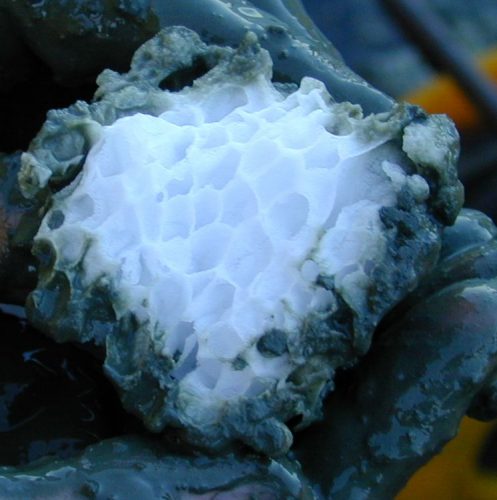In the depths of the arctic Barents Sea, north of the northernmost point of Norway, the seafloor is pocked with large craters and mounds. These craters don’t have their origins in fire, but in ice. Researchers believe that they formed due to the sudden breakdown of gas hydrate, an ice-like substance found both in seafloor sediments and on land, which can rapidly transition from a solid to a gas. New research led by Karin Andreassen at the University of Norway suggests that these craters released great expulsions of gas at the end of the last Ice Age. Furthermore, the study suggests that receding ice sheets were a primary factor in drawing these gases—which mostly consist of methane, a powerful greenhouse gas—out of the seafloor and potentially releasing them into the atmosphere.
Gas hydrates are substances that form when hydrocarbon gases interact with water and sediment under the appropriate conditions and crystallize. Though they are relatively simple compounds, the factors that control their stability—determining whether they remain solid or decompose into gas and liquid water—are surprisingly complex. The most important factors are pressure and temperature; the pressure must be high and the temperature must be low for the hydrate to remain solid.
To develop a model for the origin of the craters, Andreassen’s team combined their observations of the seafloor with a chemical analysis of the hydrates and a model of the physical conditions that would have existed in their study area over the past 30,000 years. Their findings paint a picture in which crater formation was the direct result of deglaciation.
Near the end of the last Ice Age, 17,000 years ago, more than a kilometer of solid ice lay on the seafloor at the study location. Underneath it, there was a large zone with the optimal conditions for methane hydrate formation. But within two thousand years, that ice sheet receded from the area due to the warming climate. “It happened quite fast,” Andreassen said.
The loss of such a large burden of ice caused a sudden change in pressure, and to a lesser extent temperature, that shrank the zone in which methane hydrates were stable. As methane hydrates became unstable and decomposed, the newly-released gas collected underneath a shrinking cap of solid hydrate. Eventually, the concentration of great quantities of gas and hydrate in a dwindling area caused the seafloor to distend and fracture, further lowering the pressure and allowing the remaining hydrates to suddenly decompose. The scars of this runaway process are the craters that remain to this day.
Andreassen’s model is especially intriguing because it doesn’t just connect the sudden decay of gas hydrates to ice sheets; it also suggests that glaciation helps to form large quantities of gas hydrates in the first place. Methane typically leaks towards the surface from hydrocarbon deposits that lie in the bedrock far beneath the surface—the types of formations that can be drilled into for natural gas extraction. As an ice sheet advances over these area, its immense weight forces gas upwards and towards the surface where it can form gas hydrates, and as ice sheets recede, much of this hydrate then decomposes. “It’s like a big bulldozer going back and forth,” said Andreassen. “The ice will pump the gas up from the deeper reservoirs and into the shallow surface, where it can form gas hydrates.”
Methane is twenty-five times more potent than carbon-dioxide as a greenhouse gas. Methane is currently seeping from the seafloor, but most of it doesn’t reach the atmosphere—its slow release rate allows seawater to absorb it before it breaches the surface. In contrast, the events that formed the craters are believed to have occurred abruptly, thus these large quantities of gas released may have been able to bubble to the surface and enter into the atmosphere.
Researchers hope to find traces of these events in atmospheric records that will help them determine if the events contributed to the change in climate that occurred at the end of the last Ice Age. In the short-term, Andreassen’s team hopes to understand the extent of gas hydrates and craters across the Arctic Ocean, since large areas experienced a similar glacial history and may have undergone the same process of hydrate production. By developing a clearer picture of the history of gas hydrates in Arctic areas, researchers may be able to predict how a similar process might unfold in the future; to find ice sheets that are quickly receding, one need not look back fifteen millennia.

